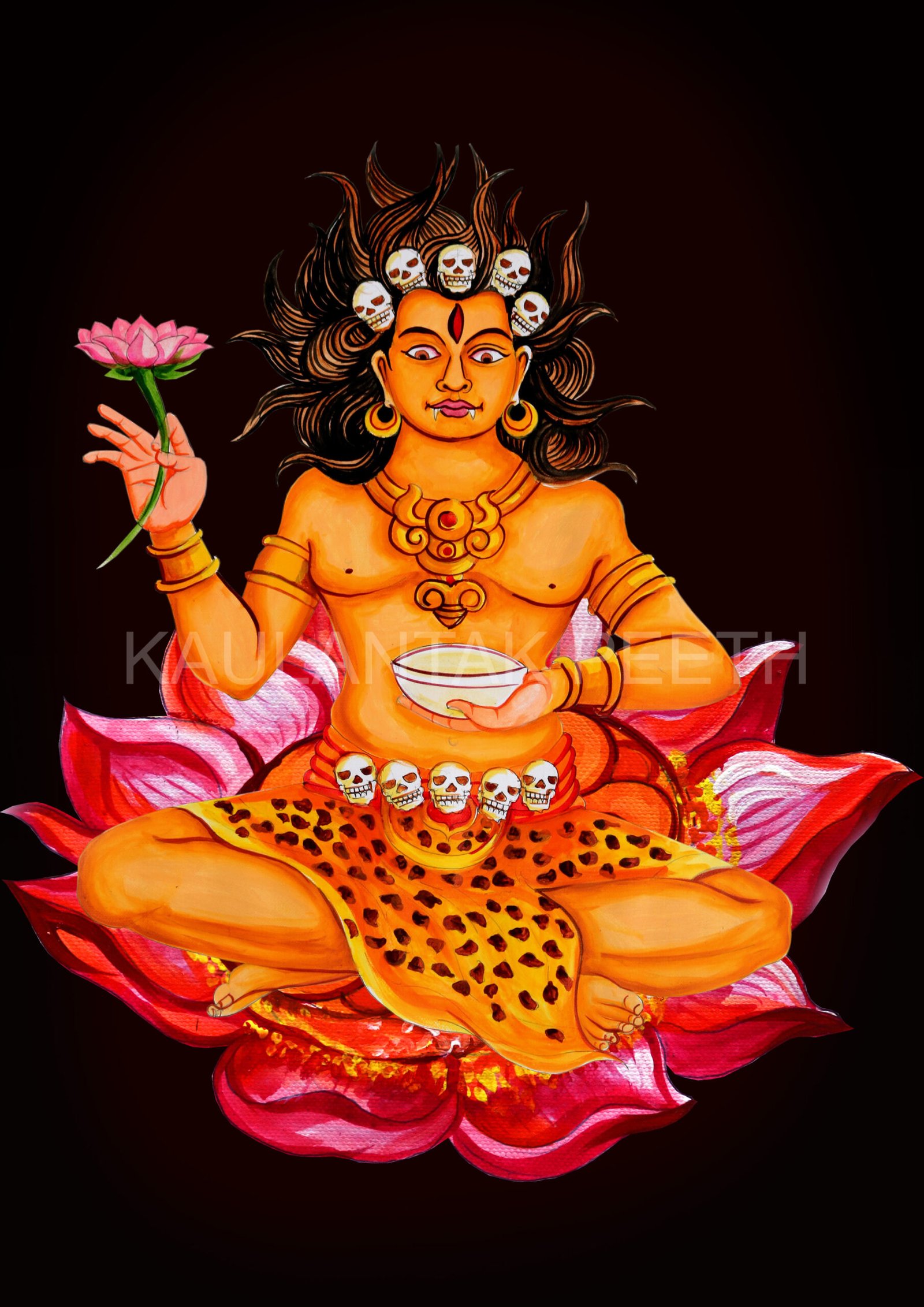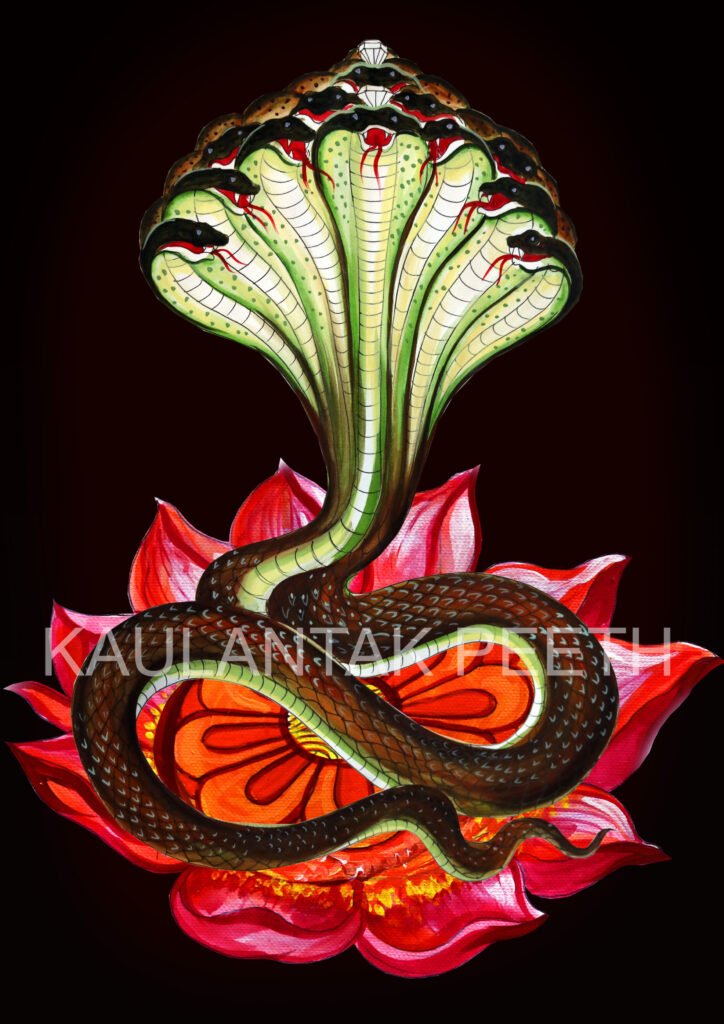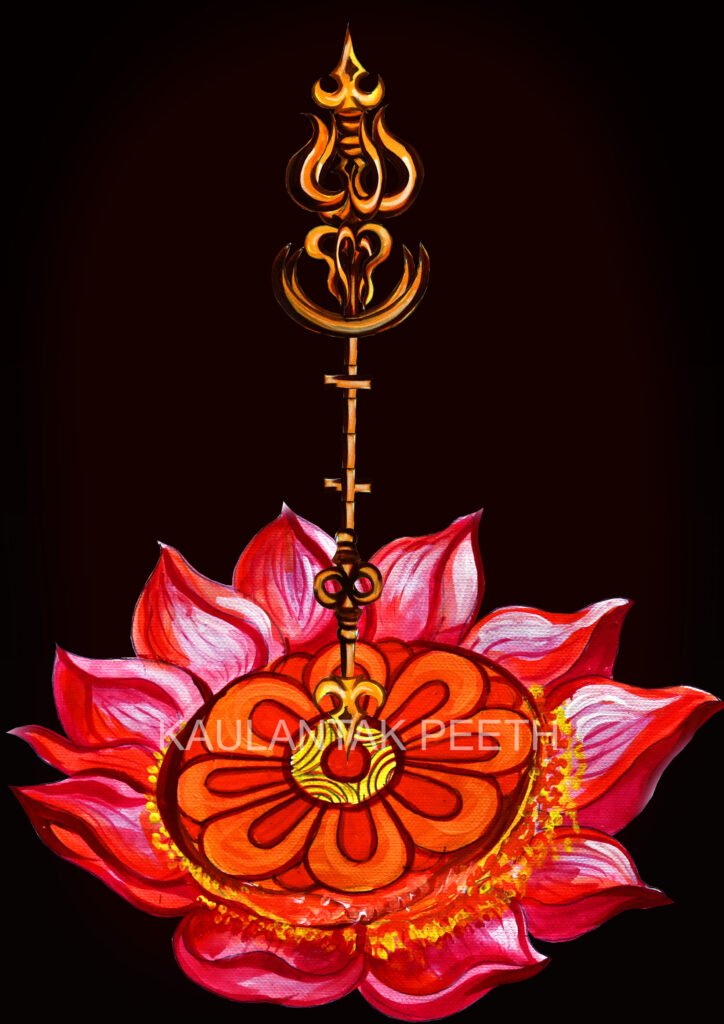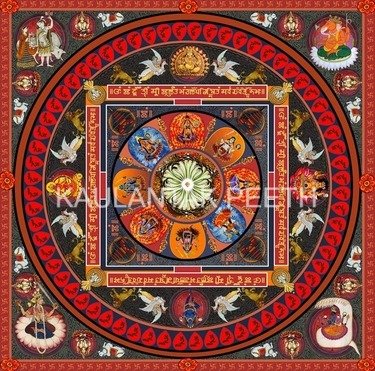‘Jeeva Pash Mukti’ is a ‘Patala’ (chapter) under the great Granth (book) of Siddha Dharma. ‘Deva Samadhi Tantra’ is the Granth of Deva Dharma written by Mahasiddha Gana Chakra Nath (महासिद्ध गण चक्र नाथ ). The ‘Patala’ of ‘Jeeva Pash Mukti’ presents the philosophy of ‘Jeeva’ (humans), ‘Pash’ (bondages) and ‘Mukti’ (ultimate freedom). We are the ‘Jeeva’ and we are bound in many kinds of ‘Paash’ (bondages). This chapter called the ‘Jeeva Pash Mukti’ of the Granth ‘Deva Samadhi Tantra’ presents the wisdom system, from the lineage of Himalayan Siddhas, on what are these ‘Paash’ (bondages), kinds of ‘Paash’ and how to free oneself from these ‘Paash’ in the present lifetime.
‘Jeeva Pash Mukti’ elaborates the techniques of Mantra, Dhyan (meditation), different kinds of rituals, prayers, Karmakand rituals, visualisations, Mandala Yantra Dhyan of Devi-Devatas along with their consort ‘Shakti’ (of the Devi-Devatas), attendant Bhairavs and ‘Mandala Yantra Dhyan’ of the Mahasiddhas. Myriad ‘Vadya Yantras’ (musical instruments), ‘Raag’, music of the Deva Dharm Tradition are used in some of these aforementioned practices.
Goal: ‘Jeeva Pash Mukti’
The supreme purpose of ‘Jeeva Pash Mukti’ is to attain absolute liberation. To study this ‘Patala’ is to understand ‘Maya’ (illusions), understand the ‘self’ and to understand one’s own experiences. Once the seeker imbibes this wisdom, then he moves towards the goal of attaining the Absolute Liberation.
The first step is to break the ‘Pashu Paash’ (shackles of animalistic nature) in oneself and attain ‘Daivatva’ (Divine virtues like of Devi-Devatas). Only after this the practitioner can become one with the ‘Brahm’, that is to merge in ‘Brahman’. This state is also known as the Absolute Liberation.
‘Jeeva Pash Mukti’ explains that if one wants to bind oneself in different bondages, living in this illusory world, one can become ‘Jada’ (inert) to infinite levels. While if one moves towards the different states of enlightenment, ultimately one can progress towards ‘Brahm’ (Supreme Consciousness) and merge in it.
‘Jeeva Pash Mukti’ Patal explains that we are not the ‘Jeeva’ (this body), but we are the ‘Atman’ (soul). In the flow of the Universe, we take different births, in different ‘Lokas’ (dimensions). The Himalayan Siddhas tell us that there are many ‘Bhuvana’ and ‘Brahmanda’ (universes) and there are many ‘Loka’ (dimensions) in these different Universes. Right now, we are in the form of ‘Manushya Yoni’ ( life form of human being) in one of the Universes. In that Universe, there is a Loka called ‘Prithvi Loka’ ( Planet Earth). The ‘Gyat Brahmand’ (known universe) around us is known as ‘Bhu Loka’.
Here we appeared as one ‘Jeeva’ (life form). Right now we think that we are the only one in this Universe and we are the best. At this point, humans do not know about the higher forms of ‘Jeeva’ and many lower forms of ‘Jeeva’ in different dimensions in the multiverses.
First, one must realise that we are not the ‘Jeeva’ (life form of human), we are the ‘Atman’ (soul). Further, we think of ‘Paash’ (bondages) in extreme limitations. One thinks that ‘Paash’ are limited to the shackles that are outside and inside us, mostly pertaining to our minds. Most seekers approach the topic of ‘Paash’ and study only the limited perspective of shackles that bound us and make us limited. Like ‘Pancha Vikar’ and attachments are most taught subjects under ‘Paash’. But here, the wisdom system in this ‘Patala’ presents the beliefs of ‘Punar Janm’ (rebirth), different ‘Brahmanda’ (multiverses) and rebirth in different Universes, where unfathomable kinds of ‘Paash’ exist. The senses increase in higher life forms in higher ‘Lokas’ and the ‘Paash’ also increase. This ‘Patala’ explains how to be free from all kinds of ‘Paash’. When one realises that these ‘Paash’ are endless, then the deep longing for the supreme liberation appears.
Kinds of ‘Paash’
There are six sub-chapters under ‘Jeeva Pash Mukti’ Patal. These six chapters present major categories of ‘Paash’ that the Himalayan Siddhas told in this ‘Patala’. These six chapters are:
| SL No. | ‘Paash’ Category | No. of Sub-category of ‘Paash’ | Describes |
|---|---|---|---|
| 1 | Maya Paash | Eight | Attachment with Maya |
| 2 | Atma Paash | Eight | Attachment with illusory self |
| 3 | Anubhuti Paash | Eight | Attachment with experiences |
| 4 | Ananta Paash | Eight | Attachment with the flow of Universe |
| 5 | Vedana Paash | Eight | Attachment with pleasure and pain |
| 6 | Paash Brahm | Eight | Attachment with illusory different states and Divine states |
Worship Rituals to Liberate from ‘Paash’
‘Jeeva Pash Mukti’ Patal explains different techniques- both the outer techniques in form of rituals and the inner techniques in form of different ‘Dhyan’ (meditation) and visualisation practices to free oneself from different ‘Paash’.
The representative symbols of the Devi-Devatas like ‘Murti’ (idols), paintings, the Sacred Geometry in the form of Yantra and Mandalas are used as the media in different practice techniques of this ‘Patala’. During the worship rituals, the practitioner uses different ‘Mudras’ (hand gestures), instruments like ‘Ghantika’ (bell), Damru and ‘Astra’ representation like of ‘Kulankusha’ (कुलांकुश ) and so on during the practices of ‘Jeeva Pash Mukti’. Different types of Mantra chanting techniques are used during rituals. Special spiritual initiations and offering rituals (Daan and Dakshina) are integral part of the practices. Mantras are chanted in three ways, ‘Mansik’ (mental chanting), ‘Upanshu’ (whispering the Mantra) and ‘Uccha Swaras’ (loud chanting) with Swacchanda Swara, Kurukulla Swara, Sukulla Swara and Vikulla Swara.
Pre and Post Practices
The practitioner must complete Jeeva Pash Mukti Kula Prarthna’ (a kind of prayer) and the ‘Pravesh’ initiation Mantra as instructed by the Acharyas, Gurus and the Mahasiddhas under the lineage of Kulant Nath. The prayer of ‘Jeeva Pash Mukti Kula Prarthna’ is to free oneself from ‘Pashutva’ (animalistic instincts). This includes the prayers to the Mahasiddhas, Devi-Devatas and ancestors. The ‘Pravesh’ Initiation Mantra is the combined Mantra of the 64 Yogini Goddesses that liberates the seeker from all kinds of animalistic instincts and opens the doors to Divine Knowledge that lead to Absolute Liberation.
In the post practices, this ‘Patala’ explains the ‘Charya’ (lifestyle), ‘Deeksha Vidhi’ and Sadhna Vidhi (practice techniques) that include ‘Awaran Pooja’, Yoga Dhyan Vidhi, ‘Kriya’, prayers, Mantra practices with other different rituals and practices.
Sarva Deva Mahamandal
Since ‘Jeeva Pash Mukti’ is part of ‘Deva Samadhi Tantra’ Granth, this ‘Patala’ involves the Sacred Geometry of the ‘Sarva Deva Mahamandala’ including few rituals of the same. This Maha Mandal is also part of ‘Deva Mahayoga Patala’ of ‘Deva Samadhi Tantra’.
‘Sarva Deva Mahamandal’ (Sarva means all, Deva means Devi/Devatas including Mahasiddhas, Maha means great) is the supreme ‘Mandala’ of ‘Deva Samadhi Tantra’. In the centre of this supreme Mandala, there is ‘Ananta Shesh Naag’. Here Bhagwan Shri Shesh Naaga exist with His ‘ananta’ (infinite) hoods, that are circling and protecting the ‘Mahamani’ (the supreme jewel) that exist in the centre (of this Mahamandal) like the Divine Lotus Petals encircle and protect the Divine powers of all the Devis, Devatas and the Mahasiddhas in the form of ‘Tejas’. The infinite hoods of Shri Shesh Naaga also have infinite Divine ‘Mani’ (jewels). But the ‘Mahamani’ in the centre is the supreme and holds the Divine Powers of all the Devis, Devatas, Mahasiddhas and their accompanying Shaktis.
There is an infinite ‘Agni Mandal’ (fire Mandala) around Shri Shesh Naag. There are the Ashta MahaMatrikas’ with the Divine ‘Kulankush’ (कुलांकुश). Outside this Mandala, there are four great Temples of Devi Kurukulla, Devi Sukulla, Devi Vikulla and of Bhagwan Shri Swachchanda Bhairav. Outside these, there are four Deities in the four corners of this Supreme Mahamandala. King of Yakshas Kuber, Devi Brahmandodari, Devi Guhhuye Chandali in Her Tamasic form and Devi Kurukulla in the four directions. Shri Garuda and ‘Simha’ (Lion) exist on both sides of all the four Deities. There are many red petals with the ‘Beeja Mantras’ Mandala outside this. Outside the Mandala of the red petals, there are Bhagwan Shiva with Devi Parvati, Bhagwan Shri Ganesha, Bhagwan Shri Vishnu and Devi Lakshmi, Devi Yogamaya Durga along with Bhagwan Nandi and the ‘Pratinidhi Yogini Goddesses’ on both sides (the leading Yogini Goddesses). On the outside there is the border Mandala of ‘Shri Swastik’ and the eight flowers called the ‘Deva Kala Bindus’.
The visualisation techniques and the Beeja Mantras, to enter the ‘Sarva Deva Mahamandal’, differ in ‘Deva Mahayoga Patal’ and the ‘Jeeva Paash Mukti Patal’.
‘Sarva Paash Mukti’ Mandala
‘Jeeva Paash Mukti Patala’ explains that the beginner Sadhaks should worship the ‘Sarva Paash Mukti’ Mandala and practice the techniques given with it. This is especially for the beginner Sadhaks to free themselves from different ‘Paash’ as soon as possible. The prime Deities of ‘Sarva Paash Mukti’ Mandala are the Goddess Kurukulla, Bhagwan Shri Swachchanda Bhairava, different Devi-Devatas of ‘Deva Mandala’ and Mahasiddhas along with Kulant Naths.
The ‘Sarva Paash Mukti’ Mandala is simple Sacred Geometry. From outside to the centre inside, there are four ‘Bhupur’ (entry gates). There are four ‘Kulankush’ (कुलांकुश) emerging from the four corners of the ‘Bhupur’. There are two types of ‘Ghat Ganga’ (vessels with sacred water)- ‘Vahir Ghat Ganga’ (it purifies from outside) and the other is ‘Antar Ghat Ganga’ (purifies from within) on either side of ‘Kulankush’. Then there is Mandala with thirty-two petals. Inside this Mandala, there are two ‘Vrit’ (two circles). Inside the two circles there is Mandal of ‘Ashtadal’ (eight petals) with a circle inside the ‘Ashtadal’. The innermost circle has three ‘Shakti Trikon’ (downward facing triangles) with one ‘Shiv Trikon’ (upward facing triangle).
‘Deva Ashray Vidhi’
‘Deva Ashray Vidhi’ consist of set of ‘Kriyas’ (here visualization practice techniques) in which the practitioner takes the permission from his Guru, Mahasiddhas and Kulant Nath to select his/her Ishta, do intense Sadhna of his Ishta and then live in the ‘Loka’ (dimension) of his Ishta. The Sadhak visualises the ‘Loka’ of his Ishta as per the instructions given by the Guru or the Acharya and visualises that it would be the place of ultimate freedom. This is an intense practice of a series of visualisations, where the Sadhak begins to perform Divine actions in this ‘Loka’ also depending on how he visualised himself in the ‘Loka’ of his Ishta. The objective is to free oneself from various ‘Paash’.
For example, if someone has lost his pet and is going through an intense sense of loss, then the person can choose to visualise the dimension where the pet has passed on to and be with the pet in that ‘Loka’. This is based on one’s power to visualise and the fact that nothing is lost in this Universe. The person can be with his pet in that ‘Loka’ and overcome the sense of loss sooner that the pet has not been lost, but is in another ‘Brahmand’ where he can meet the pet anytime through this visualisation technique.
The visualization techniques under ‘Deva Ashray Vidhi’ are divided into three categories:
- Gana Ashray Vidhi
- Siddha Ashray Vidhi
- Deva Ashray Vidhi
Shamanism practices are also part of few techniques under practices of ‘Deva Ashray Vidhi’
There are twelve Mahasiddhas of the ‘Jeeva Paash Mukti Patala’ and ‘Sarva Paash Mukti Mandala’ along with four Kulant Naths.
| SL No. | Mahasiddha | Chapter | Amna (Mandal Direction) |
|---|---|---|---|
| 1 | Mahasiddha Samvarta Nath Mahasiddha Shardool Nath |
Maya Paash | Uttar Amna |
| 2 | Mahasiddha Kanva Nath Mahasiddha Venu Nath |
Atma Paash | Poorva Amna |
| 3 | Mahasiddha Ksheer Sagari Nath Mahasiddha Mahendra Nath |
Anubhuti Paash | Dakshina Amna |
| 4 | Mahasiddhaa Ativarcha Nath Mahasiddhaa Himvanti Nath |
Ananta Paash | Paschim Amna |
| 5 | Mahasiddha Loka Sadhu Nath Mahasiddha Trinetra Nath |
Vedana Paash | Urdhva Amna |
| 6 | Mahasiddha Arya Nath Mahasiddha Sarva Mitra Nath |
Paash Brahma | Adho Amna |
The list of four Kulant Nath who are the presiding Mahasiddhas of the chapters of ‘Jeeva and the ‘Sarva Paash Mukti Mandala’. The four Kulant Naths are also known as Chatuh Sambhav Nath (Sanskrit: चतुः संभव नाथ ).
| SL No. | Kulant Nath | Chapter | Amna |
|---|---|---|---|
| 1 | Mahasiddha Amrit Sambhav Nath | Maya Paash and Atma Paash | Uttar |
| 2 | Mahasiddha Brahma Sambhav Nath | Anubhuti Paash and Ananta Paash | Poorva |
| 3 | Mahasiddha Kala Sambhav Nath | Vedana Paash and Paash Brahma | Dakshina |
| 4 | Mahasiddha Dharma Sambhav Nath | Guhya Adhyay (Secret Chapter) | Paschim |
The techniques of the ‘Jeeva Paash Mukti Patal’ are locked with ‘Kulankush’. To unlock the practice techniques of this ‘Patala’, the Sadhak must worship the four Kulant Nath along with the present Kulant Nath, Mahasiddha Ishaputra. The ‘Rakshak Devata’ (protector God) of ‘Jeeva Paash Mukti Patal’ is Bhagwan Hayagreeva. To unlock all the Mantras of ‘Deva Samadhi Tantra’ the Sadhak needs ‘Siddha Kulantar Ghantika’ (the sacred bell of Himalayan Siddhas).





